Analysis of Leadership and Management in Iceland Foods Ltd. Report
VerifiedAdded on 2021/02/20
|10
|2857
|42
Report
AI Summary
This report provides an in-depth analysis of leadership and management practices within Iceland Foods Ltd., a British supermarket chain specializing in frozen foods. It begins with an introduction to operations management and its role in maximizing organizational profits. The report then delves into the roles and characteristics of leaders and managers, comparing their functions and responsibilities within the company. It explores how leadership and management theories, such as democratic and situational leadership, are applied in real-world scenarios, including conflict resolution and strategic implementation. The report further examines various leadership approaches, including situational, systems, and contingency approaches, assessing their strengths and weaknesses. Through this analysis, the report aims to provide a comprehensive understanding of effective leadership and management strategies in the context of Iceland Foods Ltd. and the broader business environment.
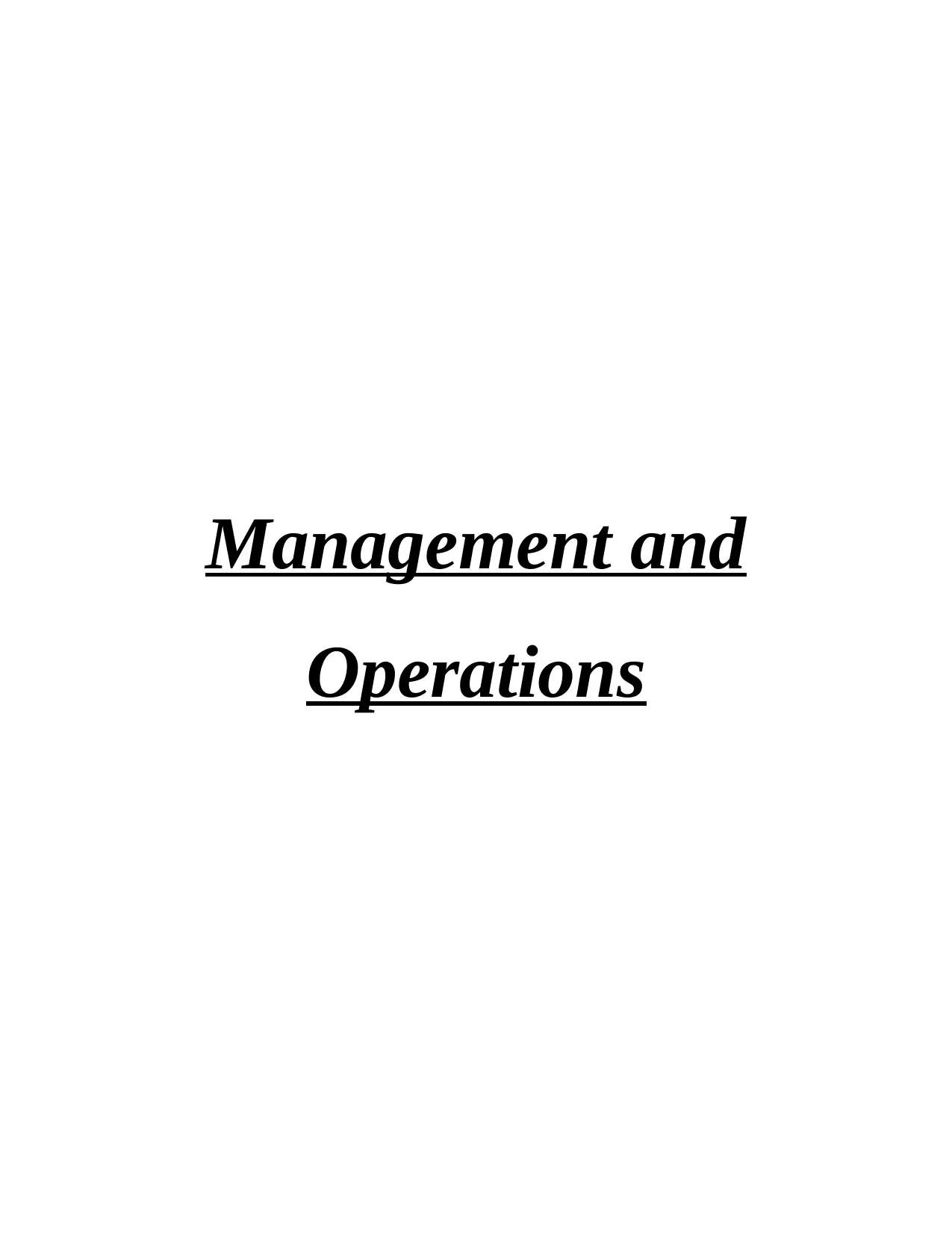
Management and
Operations
Operations
Paraphrase This Document
Need a fresh take? Get an instant paraphrase of this document with our AI Paraphraser
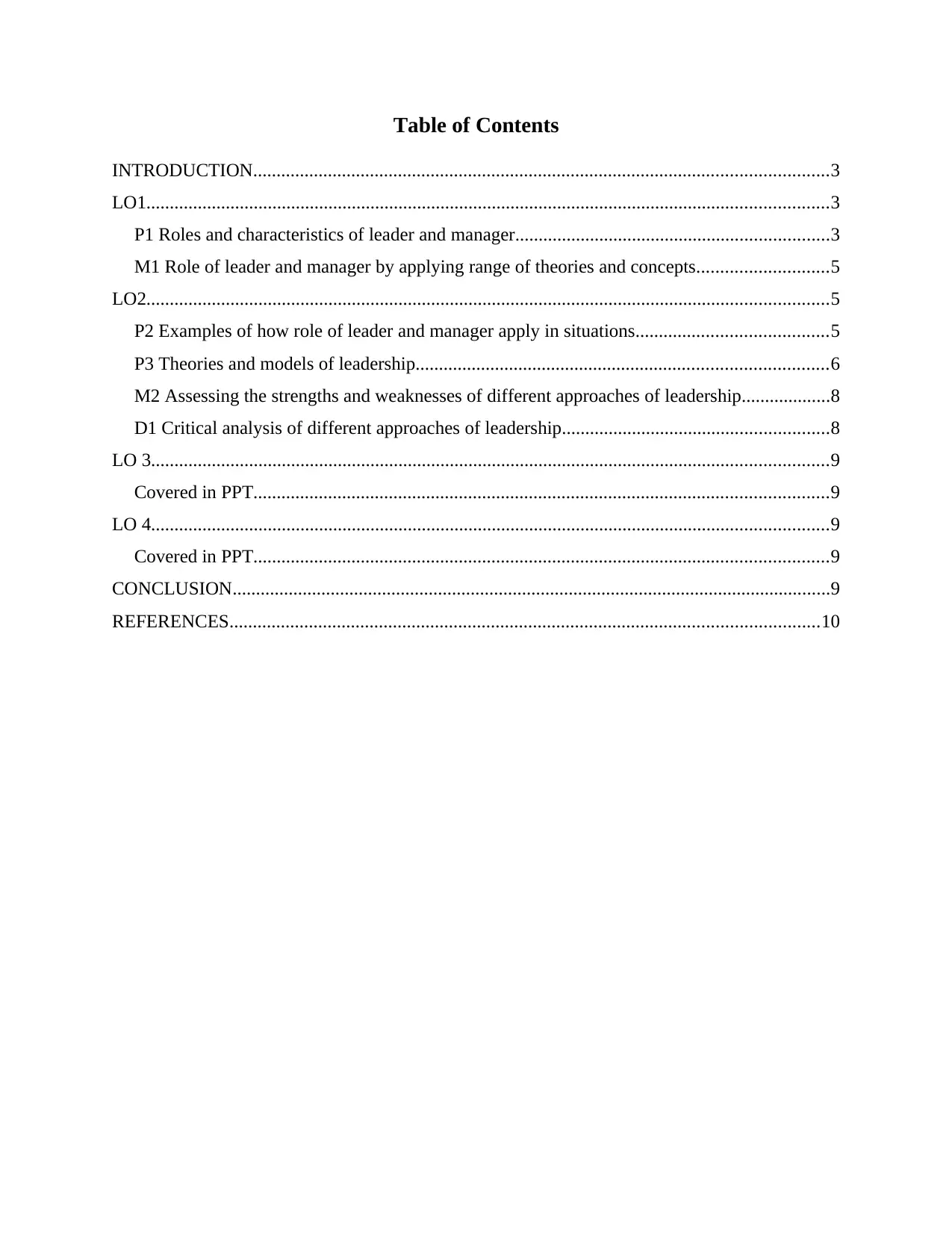
Table of Contents
INTRODUCTION...........................................................................................................................3
LO1..................................................................................................................................................3
P1 Roles and characteristics of leader and manager...................................................................3
M1 Role of leader and manager by applying range of theories and concepts............................5
LO2..................................................................................................................................................5
P2 Examples of how role of leader and manager apply in situations.........................................5
P3 Theories and models of leadership........................................................................................6
M2 Assessing the strengths and weaknesses of different approaches of leadership...................8
D1 Critical analysis of different approaches of leadership.........................................................8
LO 3.................................................................................................................................................9
Covered in PPT...........................................................................................................................9
LO 4.................................................................................................................................................9
Covered in PPT...........................................................................................................................9
CONCLUSION................................................................................................................................9
REFERENCES..............................................................................................................................10
INTRODUCTION...........................................................................................................................3
LO1..................................................................................................................................................3
P1 Roles and characteristics of leader and manager...................................................................3
M1 Role of leader and manager by applying range of theories and concepts............................5
LO2..................................................................................................................................................5
P2 Examples of how role of leader and manager apply in situations.........................................5
P3 Theories and models of leadership........................................................................................6
M2 Assessing the strengths and weaknesses of different approaches of leadership...................8
D1 Critical analysis of different approaches of leadership.........................................................8
LO 3.................................................................................................................................................9
Covered in PPT...........................................................................................................................9
LO 4.................................................................................................................................................9
Covered in PPT...........................................................................................................................9
CONCLUSION................................................................................................................................9
REFERENCES..............................................................................................................................10
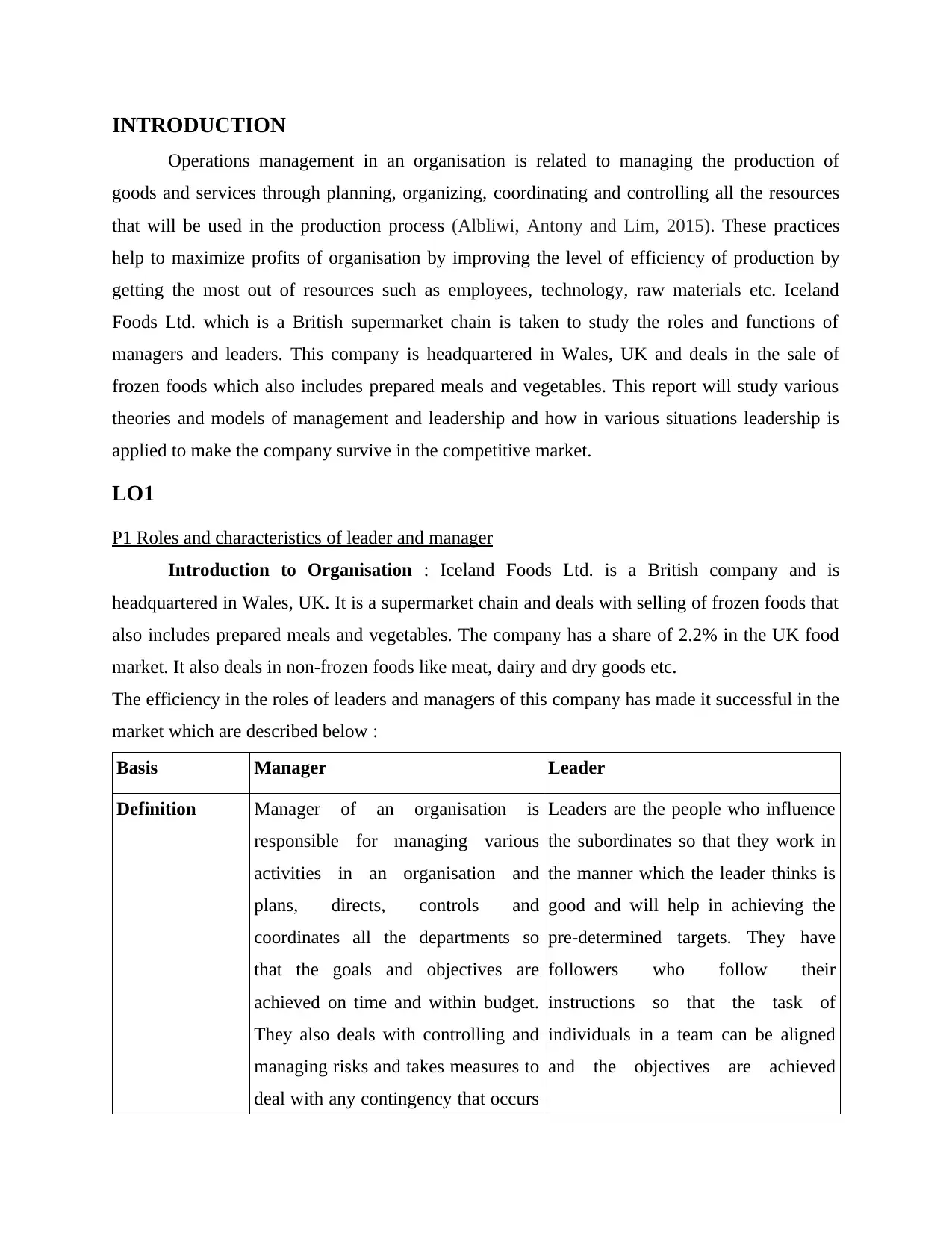
INTRODUCTION
Operations management in an organisation is related to managing the production of
goods and services through planning, organizing, coordinating and controlling all the resources
that will be used in the production process (Albliwi, Antony and Lim, 2015). These practices
help to maximize profits of organisation by improving the level of efficiency of production by
getting the most out of resources such as employees, technology, raw materials etc. Iceland
Foods Ltd. which is a British supermarket chain is taken to study the roles and functions of
managers and leaders. This company is headquartered in Wales, UK and deals in the sale of
frozen foods which also includes prepared meals and vegetables. This report will study various
theories and models of management and leadership and how in various situations leadership is
applied to make the company survive in the competitive market.
LO1
P1 Roles and characteristics of leader and manager
Introduction to Organisation : Iceland Foods Ltd. is a British company and is
headquartered in Wales, UK. It is a supermarket chain and deals with selling of frozen foods that
also includes prepared meals and vegetables. The company has a share of 2.2% in the UK food
market. It also deals in non-frozen foods like meat, dairy and dry goods etc.
The efficiency in the roles of leaders and managers of this company has made it successful in the
market which are described below :
Basis Manager Leader
Definition Manager of an organisation is
responsible for managing various
activities in an organisation and
plans, directs, controls and
coordinates all the departments so
that the goals and objectives are
achieved on time and within budget.
They also deals with controlling and
managing risks and takes measures to
deal with any contingency that occurs
Leaders are the people who influence
the subordinates so that they work in
the manner which the leader thinks is
good and will help in achieving the
pre-determined targets. They have
followers who follow their
instructions so that the task of
individuals in a team can be aligned
and the objectives are achieved
Operations management in an organisation is related to managing the production of
goods and services through planning, organizing, coordinating and controlling all the resources
that will be used in the production process (Albliwi, Antony and Lim, 2015). These practices
help to maximize profits of organisation by improving the level of efficiency of production by
getting the most out of resources such as employees, technology, raw materials etc. Iceland
Foods Ltd. which is a British supermarket chain is taken to study the roles and functions of
managers and leaders. This company is headquartered in Wales, UK and deals in the sale of
frozen foods which also includes prepared meals and vegetables. This report will study various
theories and models of management and leadership and how in various situations leadership is
applied to make the company survive in the competitive market.
LO1
P1 Roles and characteristics of leader and manager
Introduction to Organisation : Iceland Foods Ltd. is a British company and is
headquartered in Wales, UK. It is a supermarket chain and deals with selling of frozen foods that
also includes prepared meals and vegetables. The company has a share of 2.2% in the UK food
market. It also deals in non-frozen foods like meat, dairy and dry goods etc.
The efficiency in the roles of leaders and managers of this company has made it successful in the
market which are described below :
Basis Manager Leader
Definition Manager of an organisation is
responsible for managing various
activities in an organisation and
plans, directs, controls and
coordinates all the departments so
that the goals and objectives are
achieved on time and within budget.
They also deals with controlling and
managing risks and takes measures to
deal with any contingency that occurs
Leaders are the people who influence
the subordinates so that they work in
the manner which the leader thinks is
good and will help in achieving the
pre-determined targets. They have
followers who follow their
instructions so that the task of
individuals in a team can be aligned
and the objectives are achieved
⊘ This is a preview!⊘
Do you want full access?
Subscribe today to unlock all pages.

Trusted by 1+ million students worldwide
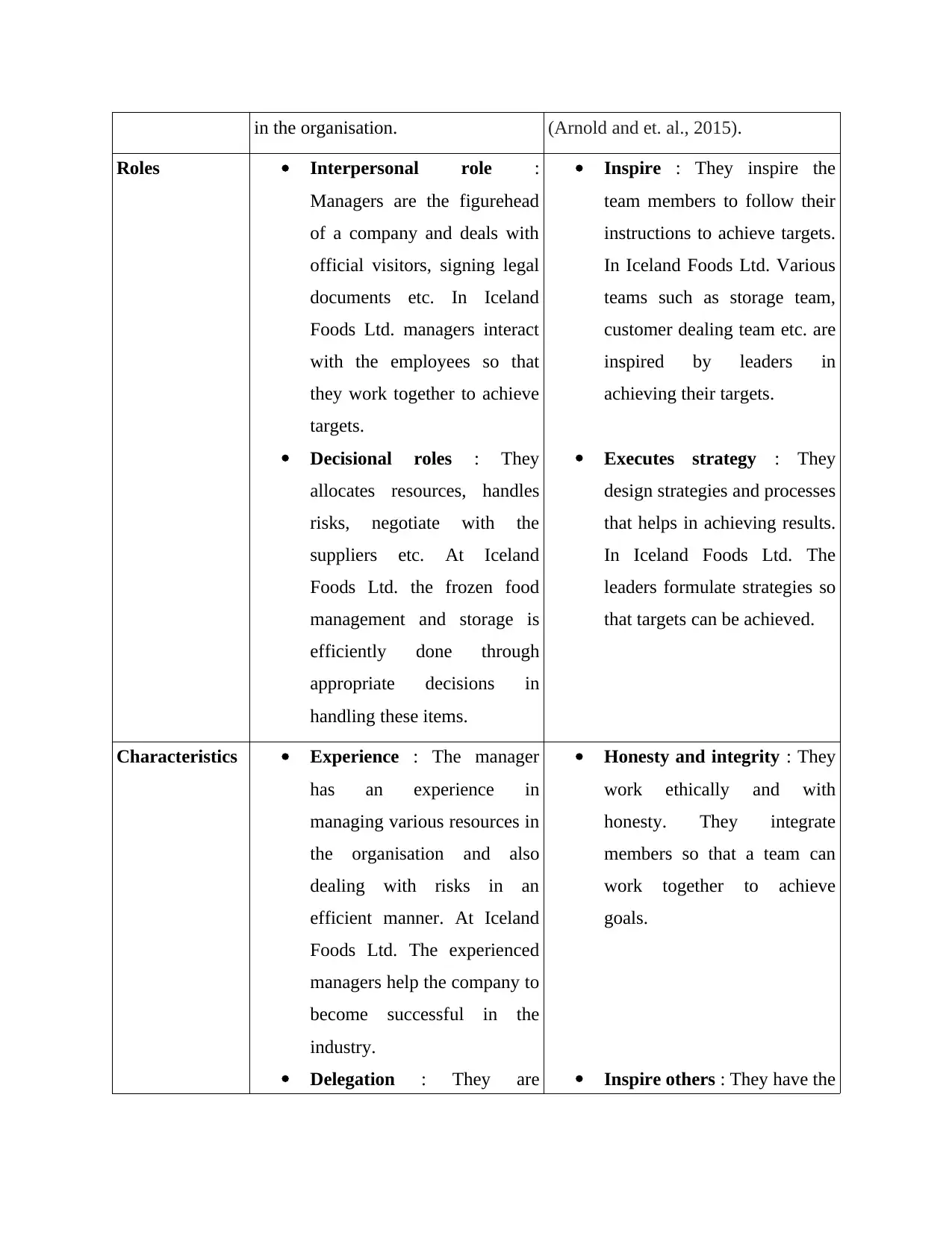
in the organisation. (Arnold and et. al., 2015).
Roles Interpersonal role :
Managers are the figurehead
of a company and deals with
official visitors, signing legal
documents etc. In Iceland
Foods Ltd. managers interact
with the employees so that
they work together to achieve
targets.
Decisional roles : They
allocates resources, handles
risks, negotiate with the
suppliers etc. At Iceland
Foods Ltd. the frozen food
management and storage is
efficiently done through
appropriate decisions in
handling these items.
Inspire : They inspire the
team members to follow their
instructions to achieve targets.
In Iceland Foods Ltd. Various
teams such as storage team,
customer dealing team etc. are
inspired by leaders in
achieving their targets.
Executes strategy : They
design strategies and processes
that helps in achieving results.
In Iceland Foods Ltd. The
leaders formulate strategies so
that targets can be achieved.
Characteristics Experience : The manager
has an experience in
managing various resources in
the organisation and also
dealing with risks in an
efficient manner. At Iceland
Foods Ltd. The experienced
managers help the company to
become successful in the
industry.
Delegation : They are
Honesty and integrity : They
work ethically and with
honesty. They integrate
members so that a team can
work together to achieve
goals.
Inspire others : They have the
Roles Interpersonal role :
Managers are the figurehead
of a company and deals with
official visitors, signing legal
documents etc. In Iceland
Foods Ltd. managers interact
with the employees so that
they work together to achieve
targets.
Decisional roles : They
allocates resources, handles
risks, negotiate with the
suppliers etc. At Iceland
Foods Ltd. the frozen food
management and storage is
efficiently done through
appropriate decisions in
handling these items.
Inspire : They inspire the
team members to follow their
instructions to achieve targets.
In Iceland Foods Ltd. Various
teams such as storage team,
customer dealing team etc. are
inspired by leaders in
achieving their targets.
Executes strategy : They
design strategies and processes
that helps in achieving results.
In Iceland Foods Ltd. The
leaders formulate strategies so
that targets can be achieved.
Characteristics Experience : The manager
has an experience in
managing various resources in
the organisation and also
dealing with risks in an
efficient manner. At Iceland
Foods Ltd. The experienced
managers help the company to
become successful in the
industry.
Delegation : They are
Honesty and integrity : They
work ethically and with
honesty. They integrate
members so that a team can
work together to achieve
goals.
Inspire others : They have the
Paraphrase This Document
Need a fresh take? Get an instant paraphrase of this document with our AI Paraphraser
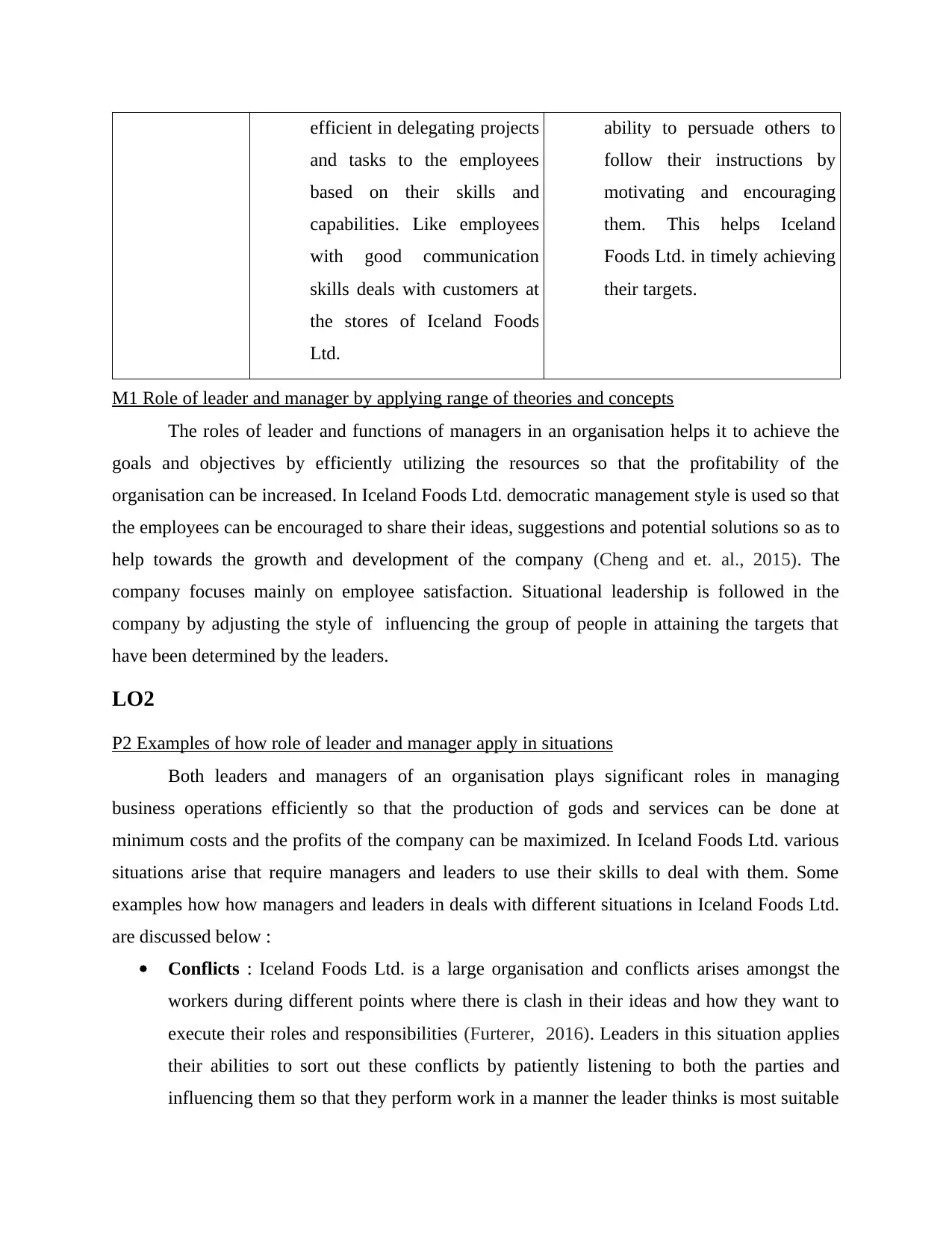
efficient in delegating projects
and tasks to the employees
based on their skills and
capabilities. Like employees
with good communication
skills deals with customers at
the stores of Iceland Foods
Ltd.
ability to persuade others to
follow their instructions by
motivating and encouraging
them. This helps Iceland
Foods Ltd. in timely achieving
their targets.
M1 Role of leader and manager by applying range of theories and concepts
The roles of leader and functions of managers in an organisation helps it to achieve the
goals and objectives by efficiently utilizing the resources so that the profitability of the
organisation can be increased. In Iceland Foods Ltd. democratic management style is used so that
the employees can be encouraged to share their ideas, suggestions and potential solutions so as to
help towards the growth and development of the company (Cheng and et. al., 2015). The
company focuses mainly on employee satisfaction. Situational leadership is followed in the
company by adjusting the style of influencing the group of people in attaining the targets that
have been determined by the leaders.
LO2
P2 Examples of how role of leader and manager apply in situations
Both leaders and managers of an organisation plays significant roles in managing
business operations efficiently so that the production of gods and services can be done at
minimum costs and the profits of the company can be maximized. In Iceland Foods Ltd. various
situations arise that require managers and leaders to use their skills to deal with them. Some
examples how how managers and leaders in deals with different situations in Iceland Foods Ltd.
are discussed below :
Conflicts : Iceland Foods Ltd. is a large organisation and conflicts arises amongst the
workers during different points where there is clash in their ideas and how they want to
execute their roles and responsibilities (Furterer, 2016). Leaders in this situation applies
their abilities to sort out these conflicts by patiently listening to both the parties and
influencing them so that they perform work in a manner the leader thinks is most suitable
and tasks to the employees
based on their skills and
capabilities. Like employees
with good communication
skills deals with customers at
the stores of Iceland Foods
Ltd.
ability to persuade others to
follow their instructions by
motivating and encouraging
them. This helps Iceland
Foods Ltd. in timely achieving
their targets.
M1 Role of leader and manager by applying range of theories and concepts
The roles of leader and functions of managers in an organisation helps it to achieve the
goals and objectives by efficiently utilizing the resources so that the profitability of the
organisation can be increased. In Iceland Foods Ltd. democratic management style is used so that
the employees can be encouraged to share their ideas, suggestions and potential solutions so as to
help towards the growth and development of the company (Cheng and et. al., 2015). The
company focuses mainly on employee satisfaction. Situational leadership is followed in the
company by adjusting the style of influencing the group of people in attaining the targets that
have been determined by the leaders.
LO2
P2 Examples of how role of leader and manager apply in situations
Both leaders and managers of an organisation plays significant roles in managing
business operations efficiently so that the production of gods and services can be done at
minimum costs and the profits of the company can be maximized. In Iceland Foods Ltd. various
situations arise that require managers and leaders to use their skills to deal with them. Some
examples how how managers and leaders in deals with different situations in Iceland Foods Ltd.
are discussed below :
Conflicts : Iceland Foods Ltd. is a large organisation and conflicts arises amongst the
workers during different points where there is clash in their ideas and how they want to
execute their roles and responsibilities (Furterer, 2016). Leaders in this situation applies
their abilities to sort out these conflicts by patiently listening to both the parties and
influencing them so that they perform work in a manner the leader thinks is most suitable
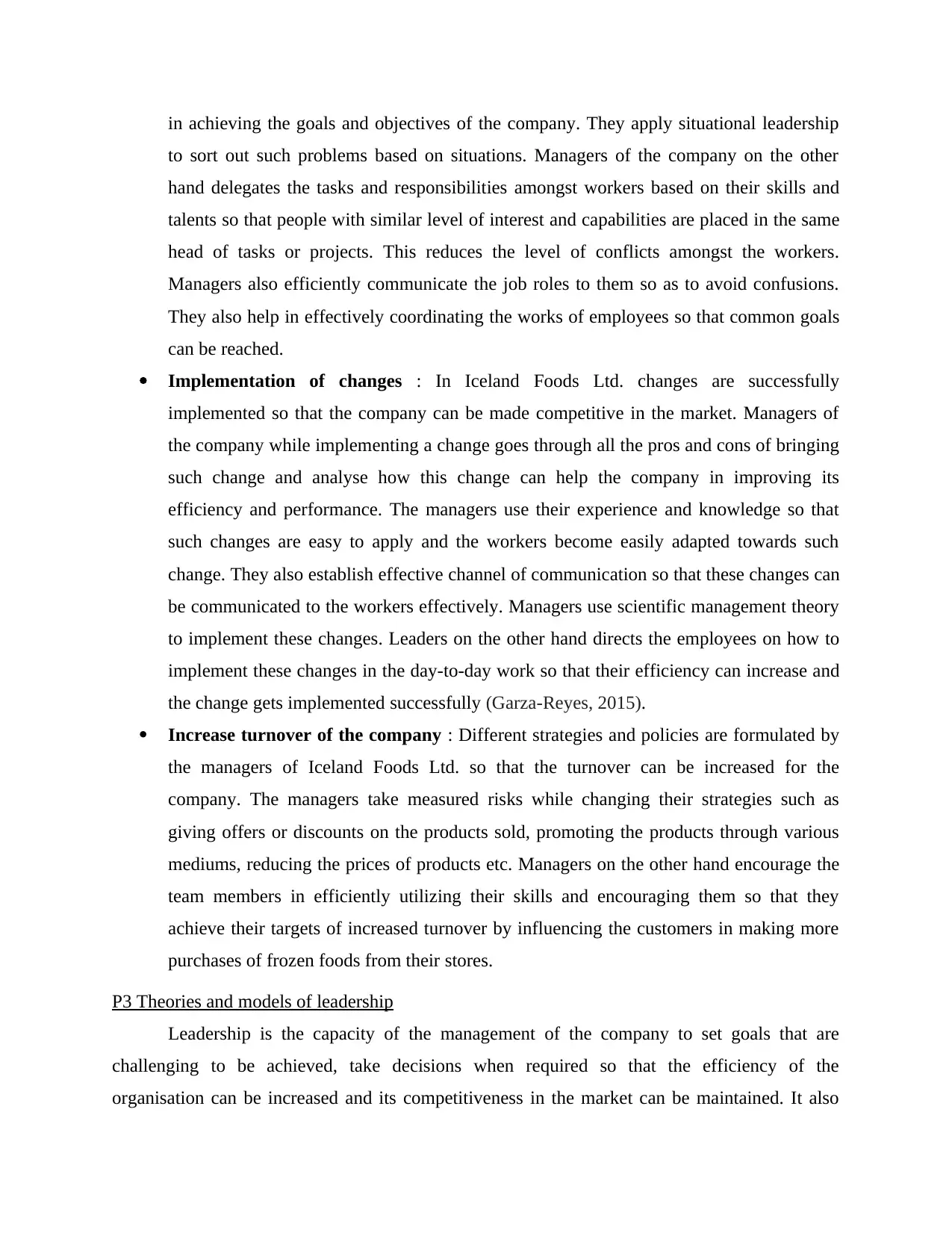
in achieving the goals and objectives of the company. They apply situational leadership
to sort out such problems based on situations. Managers of the company on the other
hand delegates the tasks and responsibilities amongst workers based on their skills and
talents so that people with similar level of interest and capabilities are placed in the same
head of tasks or projects. This reduces the level of conflicts amongst the workers.
Managers also efficiently communicate the job roles to them so as to avoid confusions.
They also help in effectively coordinating the works of employees so that common goals
can be reached.
Implementation of changes : In Iceland Foods Ltd. changes are successfully
implemented so that the company can be made competitive in the market. Managers of
the company while implementing a change goes through all the pros and cons of bringing
such change and analyse how this change can help the company in improving its
efficiency and performance. The managers use their experience and knowledge so that
such changes are easy to apply and the workers become easily adapted towards such
change. They also establish effective channel of communication so that these changes can
be communicated to the workers effectively. Managers use scientific management theory
to implement these changes. Leaders on the other hand directs the employees on how to
implement these changes in the day-to-day work so that their efficiency can increase and
the change gets implemented successfully (Garza-Reyes, 2015).
Increase turnover of the company : Different strategies and policies are formulated by
the managers of Iceland Foods Ltd. so that the turnover can be increased for the
company. The managers take measured risks while changing their strategies such as
giving offers or discounts on the products sold, promoting the products through various
mediums, reducing the prices of products etc. Managers on the other hand encourage the
team members in efficiently utilizing their skills and encouraging them so that they
achieve their targets of increased turnover by influencing the customers in making more
purchases of frozen foods from their stores.
P3 Theories and models of leadership
Leadership is the capacity of the management of the company to set goals that are
challenging to be achieved, take decisions when required so that the efficiency of the
organisation can be increased and its competitiveness in the market can be maintained. It also
to sort out such problems based on situations. Managers of the company on the other
hand delegates the tasks and responsibilities amongst workers based on their skills and
talents so that people with similar level of interest and capabilities are placed in the same
head of tasks or projects. This reduces the level of conflicts amongst the workers.
Managers also efficiently communicate the job roles to them so as to avoid confusions.
They also help in effectively coordinating the works of employees so that common goals
can be reached.
Implementation of changes : In Iceland Foods Ltd. changes are successfully
implemented so that the company can be made competitive in the market. Managers of
the company while implementing a change goes through all the pros and cons of bringing
such change and analyse how this change can help the company in improving its
efficiency and performance. The managers use their experience and knowledge so that
such changes are easy to apply and the workers become easily adapted towards such
change. They also establish effective channel of communication so that these changes can
be communicated to the workers effectively. Managers use scientific management theory
to implement these changes. Leaders on the other hand directs the employees on how to
implement these changes in the day-to-day work so that their efficiency can increase and
the change gets implemented successfully (Garza-Reyes, 2015).
Increase turnover of the company : Different strategies and policies are formulated by
the managers of Iceland Foods Ltd. so that the turnover can be increased for the
company. The managers take measured risks while changing their strategies such as
giving offers or discounts on the products sold, promoting the products through various
mediums, reducing the prices of products etc. Managers on the other hand encourage the
team members in efficiently utilizing their skills and encouraging them so that they
achieve their targets of increased turnover by influencing the customers in making more
purchases of frozen foods from their stores.
P3 Theories and models of leadership
Leadership is the capacity of the management of the company to set goals that are
challenging to be achieved, take decisions when required so that the efficiency of the
organisation can be increased and its competitiveness in the market can be maintained. It also
⊘ This is a preview!⊘
Do you want full access?
Subscribe today to unlock all pages.

Trusted by 1+ million students worldwide
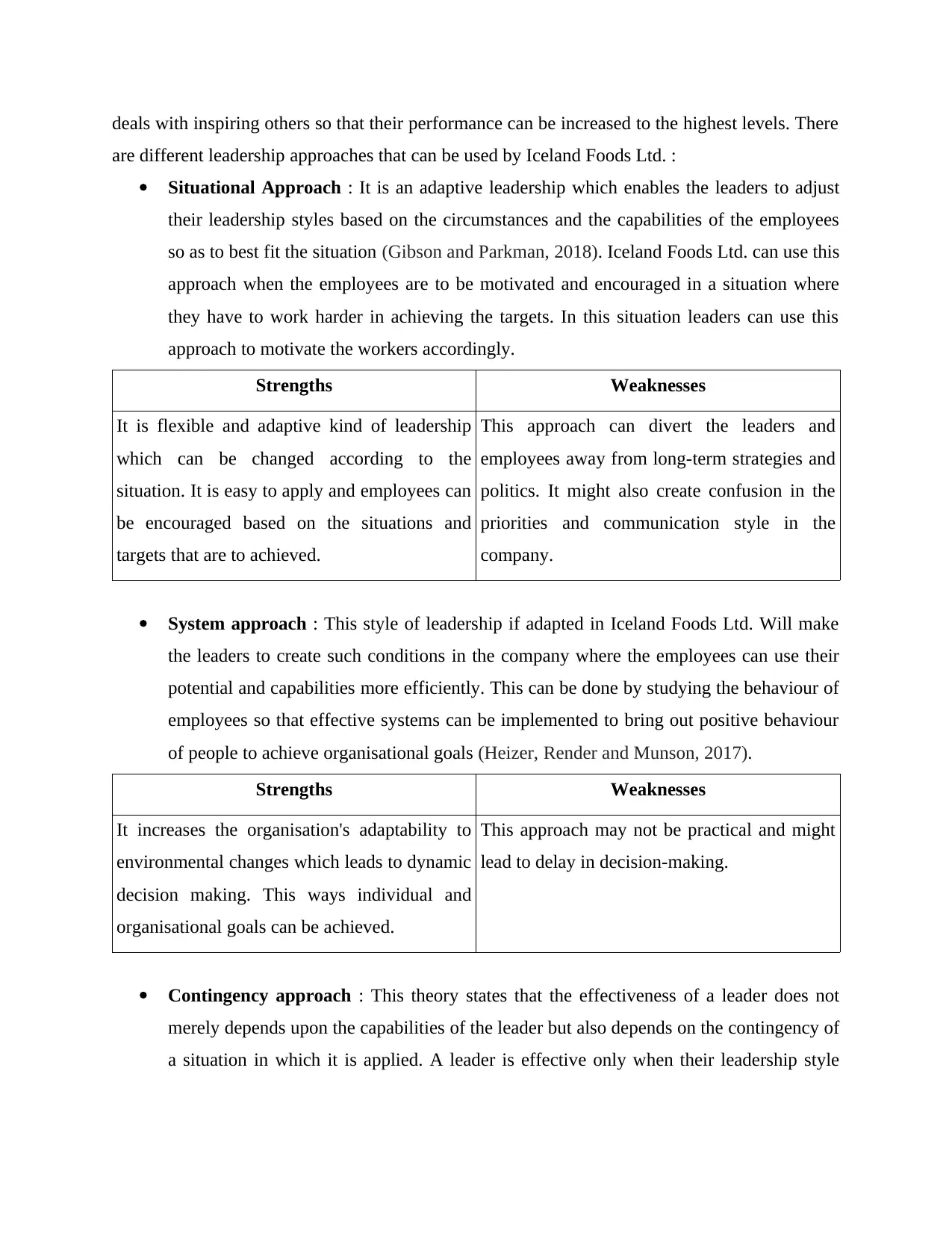
deals with inspiring others so that their performance can be increased to the highest levels. There
are different leadership approaches that can be used by Iceland Foods Ltd. :
Situational Approach : It is an adaptive leadership which enables the leaders to adjust
their leadership styles based on the circumstances and the capabilities of the employees
so as to best fit the situation (Gibson and Parkman, 2018). Iceland Foods Ltd. can use this
approach when the employees are to be motivated and encouraged in a situation where
they have to work harder in achieving the targets. In this situation leaders can use this
approach to motivate the workers accordingly.
Strengths Weaknesses
It is flexible and adaptive kind of leadership
which can be changed according to the
situation. It is easy to apply and employees can
be encouraged based on the situations and
targets that are to achieved.
This approach can divert the leaders and
employees away from long-term strategies and
politics. It might also create confusion in the
priorities and communication style in the
company.
System approach : This style of leadership if adapted in Iceland Foods Ltd. Will make
the leaders to create such conditions in the company where the employees can use their
potential and capabilities more efficiently. This can be done by studying the behaviour of
employees so that effective systems can be implemented to bring out positive behaviour
of people to achieve organisational goals (Heizer, Render and Munson, 2017).
Strengths Weaknesses
It increases the organisation's adaptability to
environmental changes which leads to dynamic
decision making. This ways individual and
organisational goals can be achieved.
This approach may not be practical and might
lead to delay in decision-making.
Contingency approach : This theory states that the effectiveness of a leader does not
merely depends upon the capabilities of the leader but also depends on the contingency of
a situation in which it is applied. A leader is effective only when their leadership style
are different leadership approaches that can be used by Iceland Foods Ltd. :
Situational Approach : It is an adaptive leadership which enables the leaders to adjust
their leadership styles based on the circumstances and the capabilities of the employees
so as to best fit the situation (Gibson and Parkman, 2018). Iceland Foods Ltd. can use this
approach when the employees are to be motivated and encouraged in a situation where
they have to work harder in achieving the targets. In this situation leaders can use this
approach to motivate the workers accordingly.
Strengths Weaknesses
It is flexible and adaptive kind of leadership
which can be changed according to the
situation. It is easy to apply and employees can
be encouraged based on the situations and
targets that are to achieved.
This approach can divert the leaders and
employees away from long-term strategies and
politics. It might also create confusion in the
priorities and communication style in the
company.
System approach : This style of leadership if adapted in Iceland Foods Ltd. Will make
the leaders to create such conditions in the company where the employees can use their
potential and capabilities more efficiently. This can be done by studying the behaviour of
employees so that effective systems can be implemented to bring out positive behaviour
of people to achieve organisational goals (Heizer, Render and Munson, 2017).
Strengths Weaknesses
It increases the organisation's adaptability to
environmental changes which leads to dynamic
decision making. This ways individual and
organisational goals can be achieved.
This approach may not be practical and might
lead to delay in decision-making.
Contingency approach : This theory states that the effectiveness of a leader does not
merely depends upon the capabilities of the leader but also depends on the contingency of
a situation in which it is applied. A leader is effective only when their leadership style
Paraphrase This Document
Need a fresh take? Get an instant paraphrase of this document with our AI Paraphraser
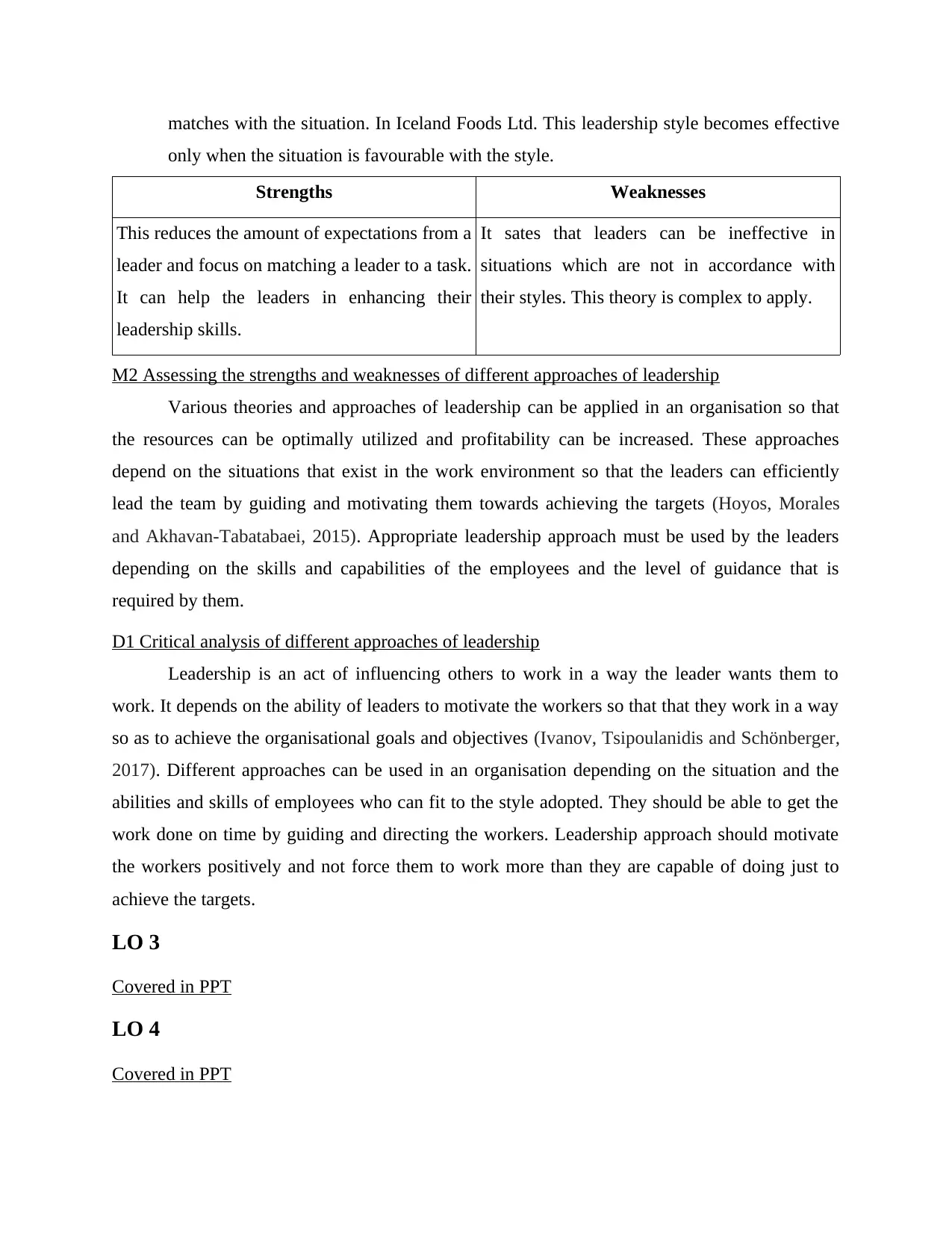
matches with the situation. In Iceland Foods Ltd. This leadership style becomes effective
only when the situation is favourable with the style.
Strengths Weaknesses
This reduces the amount of expectations from a
leader and focus on matching a leader to a task.
It can help the leaders in enhancing their
leadership skills.
It sates that leaders can be ineffective in
situations which are not in accordance with
their styles. This theory is complex to apply.
M2 Assessing the strengths and weaknesses of different approaches of leadership
Various theories and approaches of leadership can be applied in an organisation so that
the resources can be optimally utilized and profitability can be increased. These approaches
depend on the situations that exist in the work environment so that the leaders can efficiently
lead the team by guiding and motivating them towards achieving the targets (Hoyos, Morales
and Akhavan-Tabatabaei, 2015). Appropriate leadership approach must be used by the leaders
depending on the skills and capabilities of the employees and the level of guidance that is
required by them.
D1 Critical analysis of different approaches of leadership
Leadership is an act of influencing others to work in a way the leader wants them to
work. It depends on the ability of leaders to motivate the workers so that that they work in a way
so as to achieve the organisational goals and objectives (Ivanov, Tsipoulanidis and Schönberger,
2017). Different approaches can be used in an organisation depending on the situation and the
abilities and skills of employees who can fit to the style adopted. They should be able to get the
work done on time by guiding and directing the workers. Leadership approach should motivate
the workers positively and not force them to work more than they are capable of doing just to
achieve the targets.
LO 3
Covered in PPT
LO 4
Covered in PPT
only when the situation is favourable with the style.
Strengths Weaknesses
This reduces the amount of expectations from a
leader and focus on matching a leader to a task.
It can help the leaders in enhancing their
leadership skills.
It sates that leaders can be ineffective in
situations which are not in accordance with
their styles. This theory is complex to apply.
M2 Assessing the strengths and weaknesses of different approaches of leadership
Various theories and approaches of leadership can be applied in an organisation so that
the resources can be optimally utilized and profitability can be increased. These approaches
depend on the situations that exist in the work environment so that the leaders can efficiently
lead the team by guiding and motivating them towards achieving the targets (Hoyos, Morales
and Akhavan-Tabatabaei, 2015). Appropriate leadership approach must be used by the leaders
depending on the skills and capabilities of the employees and the level of guidance that is
required by them.
D1 Critical analysis of different approaches of leadership
Leadership is an act of influencing others to work in a way the leader wants them to
work. It depends on the ability of leaders to motivate the workers so that that they work in a way
so as to achieve the organisational goals and objectives (Ivanov, Tsipoulanidis and Schönberger,
2017). Different approaches can be used in an organisation depending on the situation and the
abilities and skills of employees who can fit to the style adopted. They should be able to get the
work done on time by guiding and directing the workers. Leadership approach should motivate
the workers positively and not force them to work more than they are capable of doing just to
achieve the targets.
LO 3
Covered in PPT
LO 4
Covered in PPT
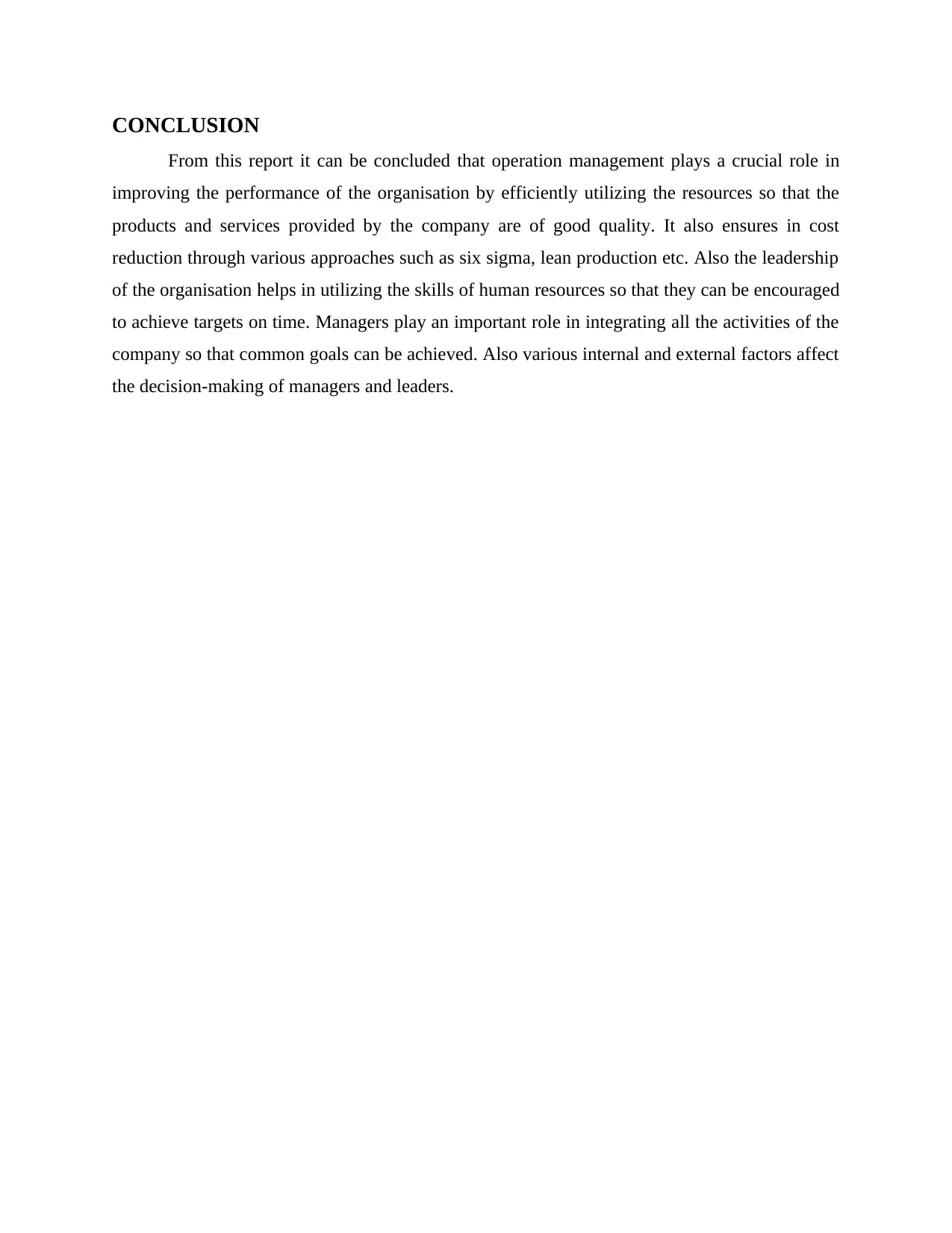
CONCLUSION
From this report it can be concluded that operation management plays a crucial role in
improving the performance of the organisation by efficiently utilizing the resources so that the
products and services provided by the company are of good quality. It also ensures in cost
reduction through various approaches such as six sigma, lean production etc. Also the leadership
of the organisation helps in utilizing the skills of human resources so that they can be encouraged
to achieve targets on time. Managers play an important role in integrating all the activities of the
company so that common goals can be achieved. Also various internal and external factors affect
the decision-making of managers and leaders.
From this report it can be concluded that operation management plays a crucial role in
improving the performance of the organisation by efficiently utilizing the resources so that the
products and services provided by the company are of good quality. It also ensures in cost
reduction through various approaches such as six sigma, lean production etc. Also the leadership
of the organisation helps in utilizing the skills of human resources so that they can be encouraged
to achieve targets on time. Managers play an important role in integrating all the activities of the
company so that common goals can be achieved. Also various internal and external factors affect
the decision-making of managers and leaders.
⊘ This is a preview!⊘
Do you want full access?
Subscribe today to unlock all pages.

Trusted by 1+ million students worldwide
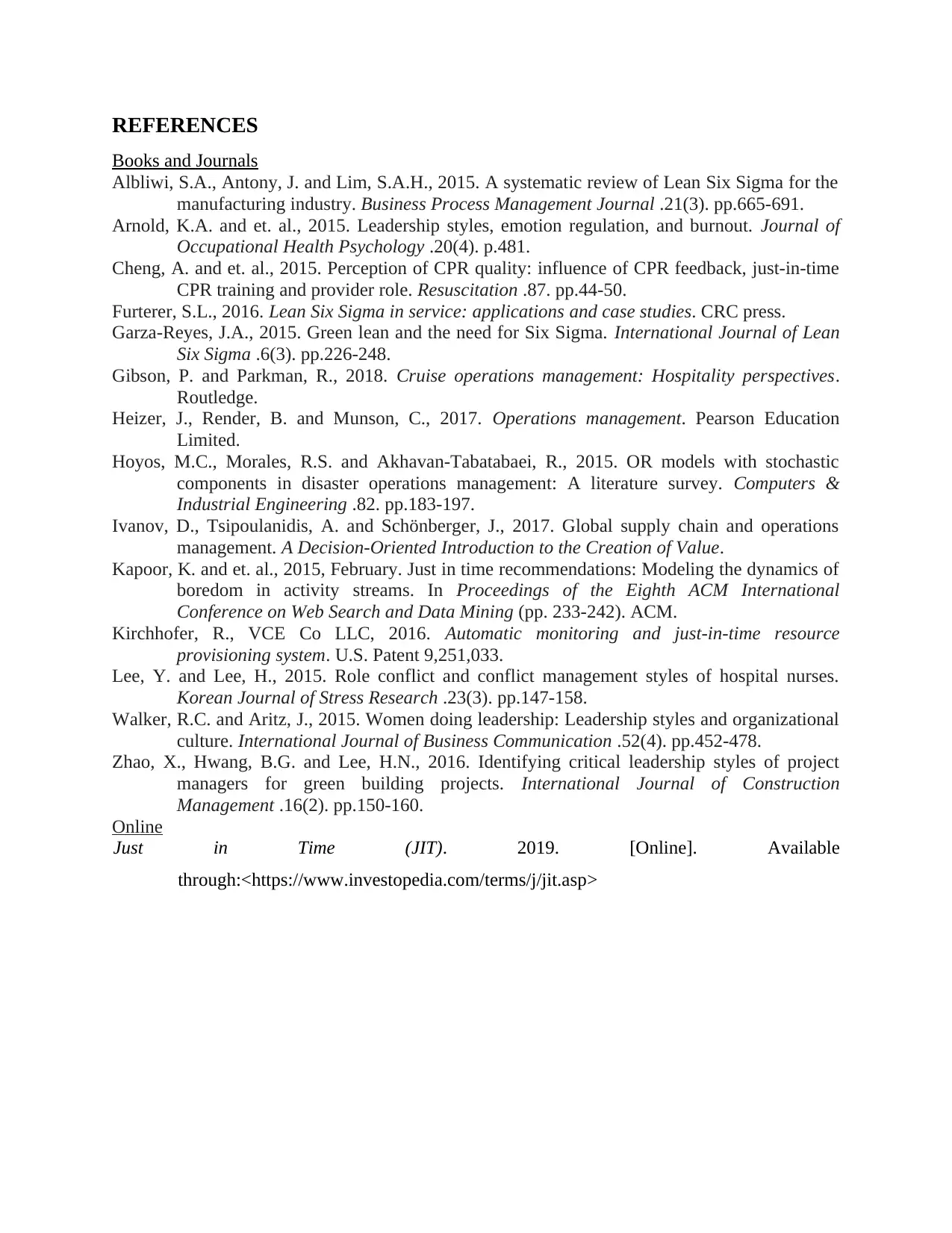
REFERENCES
Books and Journals
Albliwi, S.A., Antony, J. and Lim, S.A.H., 2015. A systematic review of Lean Six Sigma for the
manufacturing industry. Business Process Management Journal .21(3). pp.665-691.
Arnold, K.A. and et. al., 2015. Leadership styles, emotion regulation, and burnout. Journal of
Occupational Health Psychology .20(4). p.481.
Cheng, A. and et. al., 2015. Perception of CPR quality: influence of CPR feedback, just-in-time
CPR training and provider role. Resuscitation .87. pp.44-50.
Furterer, S.L., 2016. Lean Six Sigma in service: applications and case studies. CRC press.
Garza-Reyes, J.A., 2015. Green lean and the need for Six Sigma. International Journal of Lean
Six Sigma .6(3). pp.226-248.
Gibson, P. and Parkman, R., 2018. Cruise operations management: Hospitality perspectives.
Routledge.
Heizer, J., Render, B. and Munson, C., 2017. Operations management. Pearson Education
Limited.
Hoyos, M.C., Morales, R.S. and Akhavan-Tabatabaei, R., 2015. OR models with stochastic
components in disaster operations management: A literature survey. Computers &
Industrial Engineering .82. pp.183-197.
Ivanov, D., Tsipoulanidis, A. and Schönberger, J., 2017. Global supply chain and operations
management. A Decision-Oriented Introduction to the Creation of Value.
Kapoor, K. and et. al., 2015, February. Just in time recommendations: Modeling the dynamics of
boredom in activity streams. In Proceedings of the Eighth ACM International
Conference on Web Search and Data Mining (pp. 233-242). ACM.
Kirchhofer, R., VCE Co LLC, 2016. Automatic monitoring and just-in-time resource
provisioning system. U.S. Patent 9,251,033.
Lee, Y. and Lee, H., 2015. Role conflict and conflict management styles of hospital nurses.
Korean Journal of Stress Research .23(3). pp.147-158.
Walker, R.C. and Aritz, J., 2015. Women doing leadership: Leadership styles and organizational
culture. International Journal of Business Communication .52(4). pp.452-478.
Zhao, X., Hwang, B.G. and Lee, H.N., 2016. Identifying critical leadership styles of project
managers for green building projects. International Journal of Construction
Management .16(2). pp.150-160.
Online
Just in Time (JIT). 2019. [Online]. Available
through:<https://www.investopedia.com/terms/j/jit.asp>
Books and Journals
Albliwi, S.A., Antony, J. and Lim, S.A.H., 2015. A systematic review of Lean Six Sigma for the
manufacturing industry. Business Process Management Journal .21(3). pp.665-691.
Arnold, K.A. and et. al., 2015. Leadership styles, emotion regulation, and burnout. Journal of
Occupational Health Psychology .20(4). p.481.
Cheng, A. and et. al., 2015. Perception of CPR quality: influence of CPR feedback, just-in-time
CPR training and provider role. Resuscitation .87. pp.44-50.
Furterer, S.L., 2016. Lean Six Sigma in service: applications and case studies. CRC press.
Garza-Reyes, J.A., 2015. Green lean and the need for Six Sigma. International Journal of Lean
Six Sigma .6(3). pp.226-248.
Gibson, P. and Parkman, R., 2018. Cruise operations management: Hospitality perspectives.
Routledge.
Heizer, J., Render, B. and Munson, C., 2017. Operations management. Pearson Education
Limited.
Hoyos, M.C., Morales, R.S. and Akhavan-Tabatabaei, R., 2015. OR models with stochastic
components in disaster operations management: A literature survey. Computers &
Industrial Engineering .82. pp.183-197.
Ivanov, D., Tsipoulanidis, A. and Schönberger, J., 2017. Global supply chain and operations
management. A Decision-Oriented Introduction to the Creation of Value.
Kapoor, K. and et. al., 2015, February. Just in time recommendations: Modeling the dynamics of
boredom in activity streams. In Proceedings of the Eighth ACM International
Conference on Web Search and Data Mining (pp. 233-242). ACM.
Kirchhofer, R., VCE Co LLC, 2016. Automatic monitoring and just-in-time resource
provisioning system. U.S. Patent 9,251,033.
Lee, Y. and Lee, H., 2015. Role conflict and conflict management styles of hospital nurses.
Korean Journal of Stress Research .23(3). pp.147-158.
Walker, R.C. and Aritz, J., 2015. Women doing leadership: Leadership styles and organizational
culture. International Journal of Business Communication .52(4). pp.452-478.
Zhao, X., Hwang, B.G. and Lee, H.N., 2016. Identifying critical leadership styles of project
managers for green building projects. International Journal of Construction
Management .16(2). pp.150-160.
Online
Just in Time (JIT). 2019. [Online]. Available
through:<https://www.investopedia.com/terms/j/jit.asp>
1 out of 10
Related Documents
Your All-in-One AI-Powered Toolkit for Academic Success.
+13062052269
info@desklib.com
Available 24*7 on WhatsApp / Email
![[object Object]](/_next/static/media/star-bottom.7253800d.svg)
Unlock your academic potential
Copyright © 2020–2025 A2Z Services. All Rights Reserved. Developed and managed by ZUCOL.





